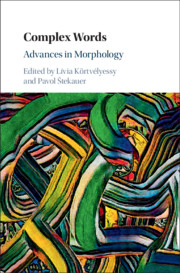Book contents
- Complex Words
- Complex Words
- Copyright page
- Dedication
- Contents
- Contributors
- Introduction: Advances in Morphology
- Part I Lexico-Semantic Aspects of Complex Words
- Part II Structure of Complex Words
- 7 Estonian Case Inflection Made Simple
- 8 Uninflectedness
- 9 Complex Exponents
- 10 Derivational Patterns in Proto-Basque Word Structure
- 11 The Complexity of Greek Verbal Morphology
- 12 Affixoids
- Part III Corpus-Based Case Studies
- Index
- References
10 - Derivational Patterns in Proto-Basque Word Structure
from Part II - Structure of Complex Words
Published online by Cambridge University Press: 18 September 2020
- Complex Words
- Complex Words
- Copyright page
- Dedication
- Contents
- Contributors
- Introduction: Advances in Morphology
- Part I Lexico-Semantic Aspects of Complex Words
- Part II Structure of Complex Words
- 7 Estonian Case Inflection Made Simple
- 8 Uninflectedness
- 9 Complex Exponents
- 10 Derivational Patterns in Proto-Basque Word Structure
- 11 The Complexity of Greek Verbal Morphology
- 12 Affixoids
- Part III Corpus-Based Case Studies
- Index
- References
Summary
Blevins (2018) presents a new reconstruction of Proto-Basque, the mother language of modern Basque varieties, historical Basque, and Aquitanian, grounded in traditional methods of historical linguistics. Building on a long tradition of Basque scholarship, the comparative method and internal reconstruction, informed by the phonetic bases of sound change and phonological typology, are used to explain previously underappreciated alternations and asymmetries in Basque sound patterns, resulting in a radically new view of the proto-language. One aspect of this new reconstuction involves word-internal structural elements unrecognized in previous work. This paper builds on the derivational patterns hypothesized for Proto-Basque in Blevins (2018), focusing on the following formatives: root-extension *-r; acategorial *s-; nominalizating *-s; nominal *ha-; and collective *hi-. Under this analysis, lexemes may have the maximally complex structure.
- Type
- Chapter
- Information
- Complex WordsAdvances in Morphology, pp. 175 - 191Publisher: Cambridge University PressPrint publication year: 2020

